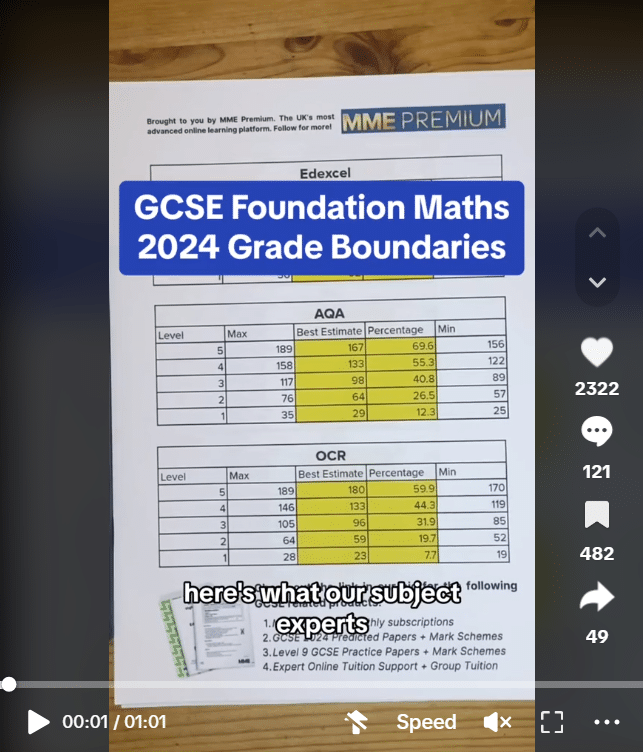Corresponding Angles and Alternate Angles
Corresponding Angles and Alternate Angles Revision
Corresponding and Alternate Angles: 4 Simple Rules
Corresponding and alternate angles are formed when a straight line passes through two parallel lines.
Parallel means that two lines are always the same distance away from each other, and therefore will never meet. Parallel lines are marked with matching arrows as shown in the examples below.
Drawing a straight line that passes through two parallel lines creates a whole bunch of angles that are all related to each other. How these angles are related is explained by 4 simple rules.
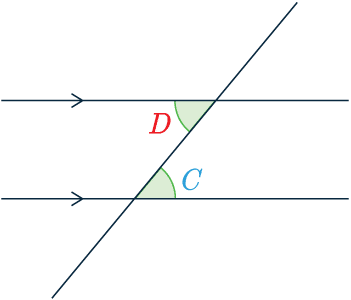
Alternate Angles:

Alternate angles are the same.
\textcolor{red}{D} = \textcolor{skyblue}{C}
They are found in a Z-shape, and sometimes called “Z angles“
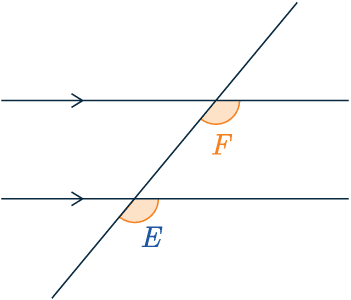
Corresponding Angles

Corresponding angles are the same.
\textcolor{orange}{F} = \textcolor{blue}{E}
They are found in an F-shape and are sometimes called “F angles“
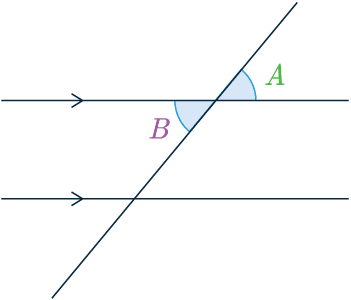
Vertically Aligned Angles

Vertically aligned angles are the same
\textcolor{limegreen}{A} = \textcolor{purple}{B}
These are often called “vertically opposite angles“.
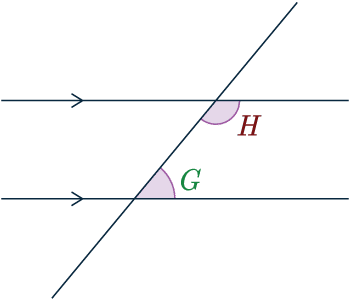
Interior / Allied angles

Allied angles add up to 180\degree
\textcolor{maroon}{H} + \textcolor{green}{G} = 180\degree
These can be refereed to as either Allied angles or Interior angles.
Example: Angles in Parallel Lines
Find the angle marked x in the picture below.
BD and EG are parallel lines.
State which angle rule you used at each step.
[2 marks]
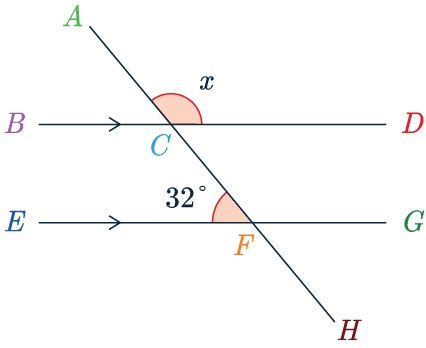
Currently we cannot see a rule connecting \angle EFC with x
This means we will need multiple steps.
Firstly, we will use the fact that angles on a straight line add to 180 degrees.
Specifically, \angle EFC and \angle CFG add to make 180\degree.
Which means we can do the following:
\angle CFG = 180\degree - 32\degree = 148\degree.
Now, looking at the diagram we can see that angle \angle CFG and the missing angle x are corresponding angles.
Therefore, we get
x = 148\degree.
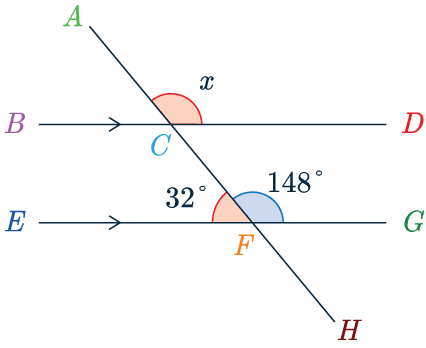
As mentioned, there are multiple ways to do this question.
Corresponding Angles and Alternate Angles Example Questions
Question 1: AHC and FGD are parallel lines. Find the angle marked x in the picture below.
State which angle rule you use at each step.
[1 mark]
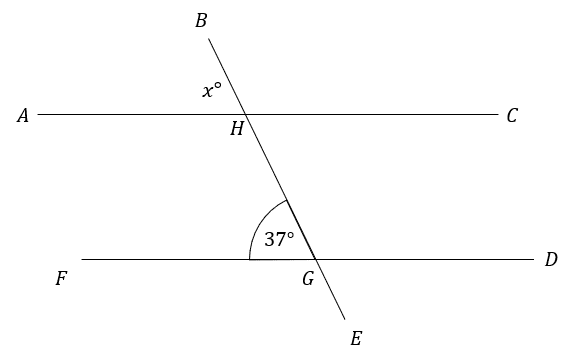
Using corresponding angles, we find that \angle \text{AHB} = \angle \text{FGH}, so \angle x = 37\degree
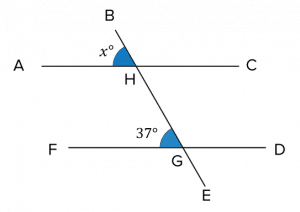
Question 2: AHC and FGD are parallel lines. Find the angle marked x in the picture below.
State which angle rule you use at each step.
[2 marks]
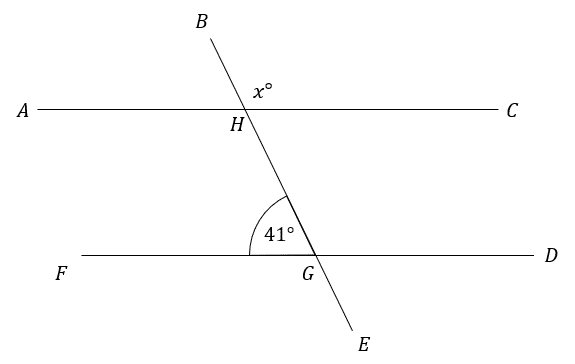
First identifying that \angle \text{FGH} and \angle \text{GHC} are alternate angles, we get
\angle \text{GHC}=41\degree
Then as \text{BE} is a straight line we can use the fact that angles on a straight line sum to 180\degree,
x=180\degree-41\degree=139\degree
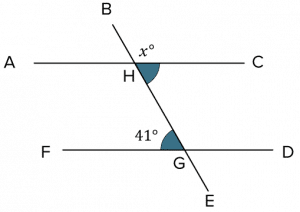
Question 3: BD and EG are parallel lines. Find the angle marked x in the picture below.
State which angle rule you use at each step.
[2 marks]
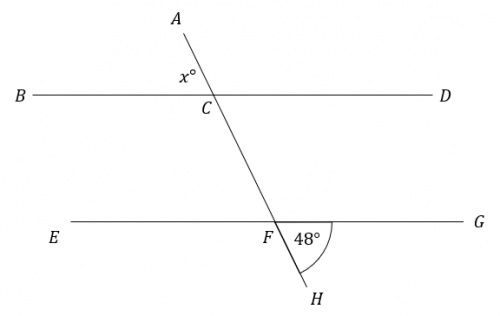
Firstly, because angle HFG and angle EFC are vertically opposite, we get
\angle \text{EFC} = 48\degree
Secondly, because angle EFC and angle BCA (\angle x) are corresponding angles, we get
\angle \text{BCA} = x = 48\degree
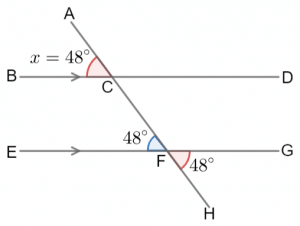
Question 4: AD and CE are parallel lines. Find the angle marked x in the picture below. State which angle rule you use at each step.
[3 marks]
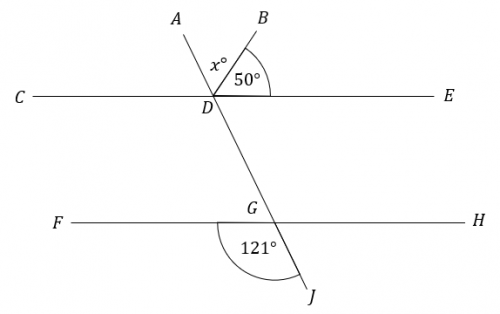
Firstly, using the fact that angles FGJ and CDG are corresponding angles, we get
\angle \text{CDG } = 121\degree
Secondly, because angles on a straight line add to 180\degree, and angles CDG and CDA are on a straight line,
\angle \text{CDA } = 180 - 121 = 59\degree
Thirdly, again using the fact that angles on a straight line add to 180\degree, and angles CDA, BDE, and ADB (otherwise known as angle x) are on a straight line, we get
x + 50 + 59 = 180,\text{ so } x = 180 - 109 = 71\degree
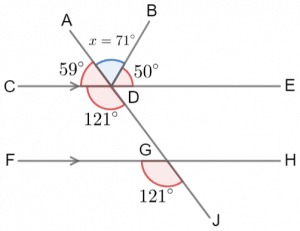
Question 5: CF and GI are parallel lines. Find the angle marked x in the picture below. State which angle rule you use at each step.
[3 marks]
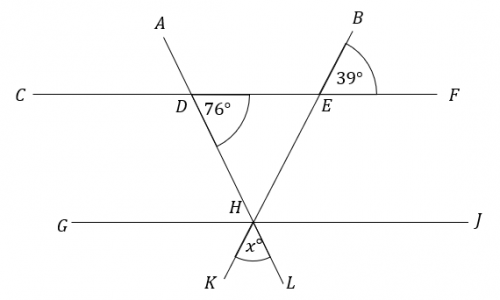
Firstly, because angles BEF and EHJ are corresponding angles, we get
\text{angle EHJ } = 39\degree.
Next, because angles EDH and DHG are alternate angles, we get
\text{angle DHG } = 76\degree.
Then, because angles DHG, DHE, and EHJ are angles on a straight line and angles on a straight line add to 180\degree, we get
\text{angle DHE } = 180 - 76 - 39 = 65\degree
Finally, because angle DHE and angle x are vertically opposite angles, we get
x = 65\degree.
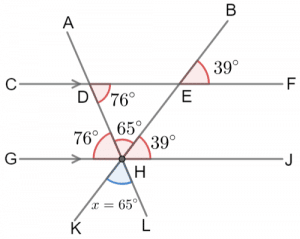
There are other possible methods for doing this question. As long as you’ve correctly applied angle fact, explained each step, and got the answer to be 71\degree, your answer is correct.
Corresponding Angles and Alternate Angles Worksheet and Example Questions
(NEW) Parallel lines Exam Style Questions - MME
Level 1-3Level 4-5GCSENewOfficial MMECorresponding Angles and Alternate Angles Drill Questions
MME Geometry Problems - Drill Questions
Level 4-5GCSE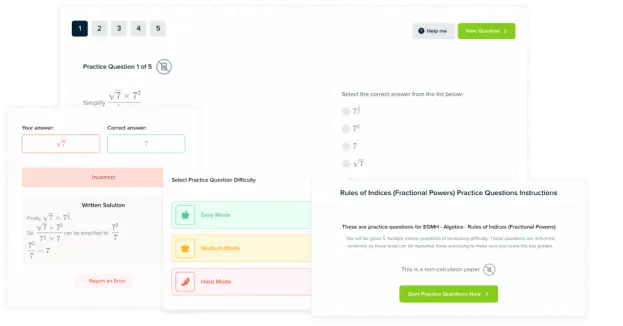
MME Premium Membership
£19.99
/monthLearn an entire GCSE course for maths, English and science on the most comprehensive online learning platform. With revision explainer videos & notes, practice questions, topic tests and full mock exams for each topic on every course, it’s easy to Learn and Revise with the MME Learning Portal.
Sign Up Now

